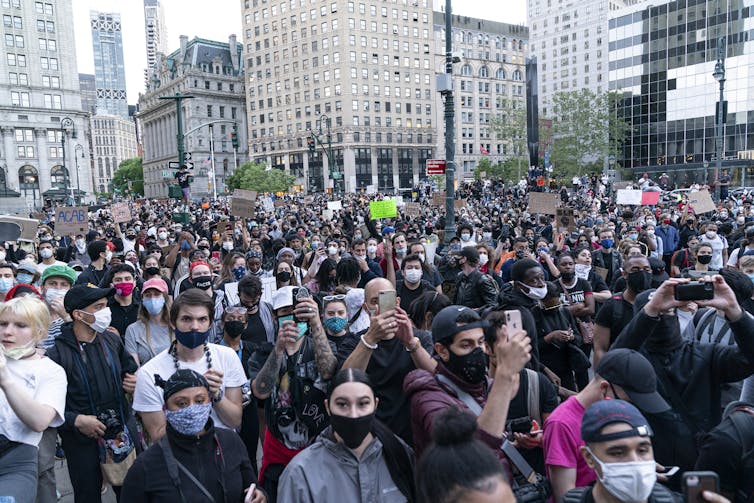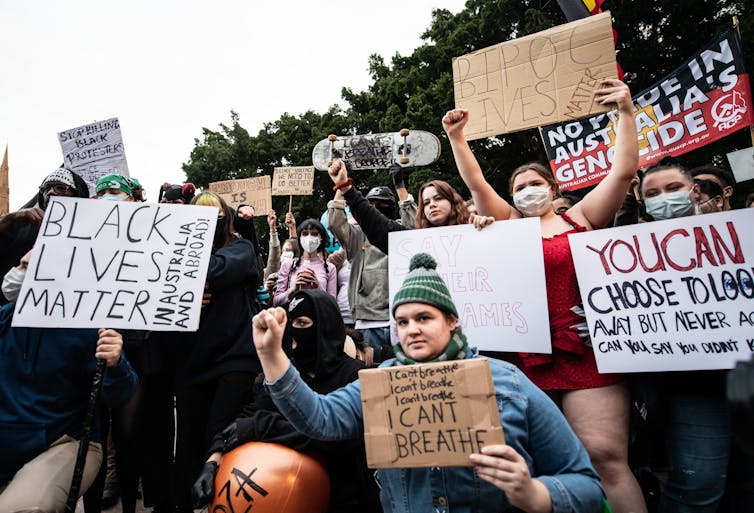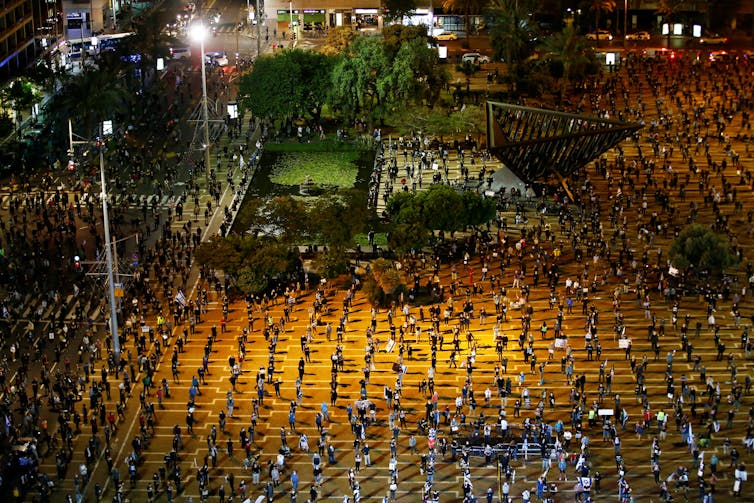Can you socially distance at a Black Lives Matter rally in Australia and New Zealand? How to protest in a coronavirus pandemic
- Written by Philip Russo, Associate Professor, Director Cabrini Monash University Department of Nursing Research, Monash University
The death of African-American man George Floyd at the hands of police has sparked protests across the United States and inspired many people to reflect on our own history of police violence against Indigenous people in Australia and New Zealand.
After thousands marched across New Zealand on Monday, a series of rallies and vigils are planned in Australian cities this week, and many have wondered: how should we safely protest during a pandemic?
As an infection prevention researcher, I am, of course, genuinely worried by the prospect of large crowds gathering. But I also completely understand why people want to go and make their feelings known on racism – not just in Australia and New Zealand, but internationally. It is a clash when we are trying to manage COVID-19 and puts us in a dilemma.
But I can’t stand and judge people who want to go.
 Huge crowds have gathered in places such as New York to protest the death of George Floyd.
Lev Radin/ AAP
Huge crowds have gathered in places such as New York to protest the death of George Floyd.
Lev Radin/ AAP
Colleagues in the US who are so moved by what’s happening there are forgoing their social distancing and putting themselves and their colleagues at risk by attending the protests. For them, it is a personal decision and a risk they are prepared to take.
In New Zealand, Prime Minister Jacinda Ardern said while “I utterly understand” why people had marched, New Zealand had social distancing rules in place to protect people’s health – and the June 1 marches were “a clear breach of them”.
NZ Prime Minister Jacinda Ardern said while she doesn’t want to stop peaceful protests, the June 1 Black Lives Matter protests across NZ were a “clear breach” of COVID-19 rules.If we had one person, one person in that crowd, just think what could happen there because we’ve seen it before […] I understand the strength of feeling and I understand the sentiment and I understand that sense of urgency that everyone felt. But my job is to look after the country’s health as well.
In Australia, people should remember many states have strict rules about public gatherings and it’s likely you’ll be breaching them if you attend a protest. In Victoria, there’s a limit of 20 people at an outdoor gathering. For NSW the limit is 10, while in Queensland the limit is 20.
Remember, coronavirus is spread via close contact, so you are significantly increasing your risk of infection if you are in a large crowd.
All that said, if you’re considering attending a protest, here are four things to think about.
Read more: The fury in US cities is rooted in a long history of racist policing, violence and inequality
1. Is there another way I can show support?
Given I’m an infection prevention researcher, working to prevent the spread of COVID-19, I have to say this: if there is any other way you can show support, other than attending a mass gathering – whether that’s donating to a group doing good work, doing any sort of online protest or whatever option you can find – you should consider it.
Think about whether you yourself are at higher risk – by being older or immuno-compromised, for example – and whether there is a more sustainable way for you to support a movement you care about.
2. Think about how you’ll get there
Plan your trip to and from the protest carefully. Avoid crowded public transport – consider driving or riding a bike if possible – and follow social distancing rules if you must travel by bus, train or tram.
Make sure you bring hand sanitiser and use it liberally. Wash hands as soon as you get home.
3. If you go, observe social distancing
If you’re in Australia, download and use the COVIDSafe app. Try as best you can to observe social distancing at any event you attend. That means staying at least 1.5 metres apart from everyone else (or 2 metres in New Zealand) whether you are standing in an open space or marching down a street. Remember that coronavirus is spread by droplets released when people breathe, talk, cough, sneeze, sing or shout in close proximity to others. No hugging to demonstrate solidarity.
 People gathered in Sydney on Tuesday to protest against the treatment of Indigenous people in custody.
James Gourley/AAP
People gathered in Sydney on Tuesday to protest against the treatment of Indigenous people in custody.
James Gourley/AAP
When you get lots of people together and emotions run high, things can go awry very quickly. I’d be prepared to leave the demonstration if I started to get concerned about the proximity of people around me. There’s a risk more people will turn up than you or the event organisers anticipated; if there are bigger crowds than expected, be prepared to make a decision to head home.
A mask alone will not protect you, they’re only one piece of the armoury and are only useful if you socially distance and wash hands as well. If you throw yourself into a situation where you are close to other people, a mask will not be enough to protect you or others.
 Israelis demonstrated in April against Israel’s Prime Minister Benjamin Netanyahu, under strict restrictions made to slow down the coronavirus disease (COVID-19) spread.
AAP/Reuters/Corinna Kern
Israelis demonstrated in April against Israel’s Prime Minister Benjamin Netanyahu, under strict restrictions made to slow down the coronavirus disease (COVID-19) spread.
AAP/Reuters/Corinna Kern
Read more: Are you wearing gloves or a mask to the shops? You might be doing it wrong
4. Do not attend if you feel unwell or have any COVID-19 symptoms
This should go without saying: absolutely stay home, no matter how strongly you feel about the issue, if you have any symptoms, such as a sore throat or a cough.
Indigenous Australians are an at-risk demographic for COVID-19, as are Māori and Pasifika, so you need to think carefully about the risk you may pose to others if you turn up while experiencing symptoms. If there was to be a small cluster in one of these protests, and the virus was passed to an Indigenous community, the effects could be devastating.
If you feel that compelled to attend a demonstration, think about anything you can do to minimise the chances of spread, or you will undo the gains Australia and New Zealand have made in keeping the coronavirus spread under control.
Read more: Riot or resistance? How media frames unrest in Minneapolis will shape public's view of protest
Authors: Philip Russo, Associate Professor, Director Cabrini Monash University Department of Nursing Research, Monash University



